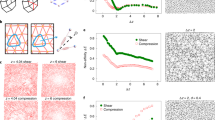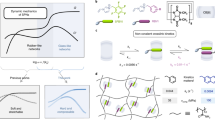Abstract
The exceptional mechanical properties of polymer nanocomposites are achieved through intimate mixing of the polymer and inorganic phases, which leads to spatial confinement of the polymer phase1,2,3,4,5. In this study we probe the mechanical and fracture properties of polymers in the extreme limits of molecular confinement, where a stiff inorganic phase confines the polymer chains to dimensions far smaller than their bulk radius of gyration. We show that polymers confined at molecular length scales dissipate energy through a confinement-induced molecular bridging mechanism that is distinct from existing entanglement-based theories of polymer deformation and fracture. We demonstrate that the toughening is controlled by the molecular size and the degree of confinement, but is ultimately limited by the strength of individual molecules.
This is a preview of subscription content, access via your institution
Access options
Subscribe to this journal
Receive 12 print issues and online access
$259.00 per year
only $21.58 per issue
Buy this article
- Purchase on Springer Link
- Instant access to full article PDF
Prices may be subject to local taxes which are calculated during checkout




Similar content being viewed by others
References
Paul, D. R. & Robeson, L. M. Polymer nanotechnology: Nanocomposites. Polymer 49, 3187–3204 (2008).
Sanchez, C., Julián, B., Belleville, P. & Popall, M. Applications of hybrid organic–inorganic nanocomposites. J. Mater. Chem. 15, 3559–3592 (2005).
Alexandre, M. & Dubois, P. Polymer layered-silicate nanocomposites: Preparation, properties and uses of a new class of materials. Mater. Sci. Eng. R 28, 1–63 (2000).
Coleman, J. N., Khan, U., Blau, W. J. & Gun’ko, Y. K. Small but strong: A review of the mechanical properties of carbon nanotube-polymer composites. Carbon 44, 1624–1652 (2006).
Gao, H., Ji, B., Jager, I. L., Arzt, E. & Fratzl, P. Materials become insensitive to flaws at nanoscale: Lessons from nature. Proc. Natl Acad. Sci. USA 100, 5597–5600 (2003).
Giesa, T., Arslan, M., Pugno, N. M. & Buehler, M. J. Nanoconfinement of spider silk fibrils begets superior strength, extensibility, and toughness. Nano Lett. 11, 5038–5046 (2011).
Keten, S., Xu, Z., Ihle, B. & Buehler, M. J. Nanoconfinement controls stiffness, strength and mechanical toughness of β-sheet crystals in silk. Nature Mater. 9, 359–367 (2010).
Czanderna, A. W. & Pern, F. J. Encapsulation of PV modules using ethylene vinyl acetate copolymer as a pottant: A critical review. Sol. Energy Mater. Sol. Cells 43, 101–181 (1996).
Niu, M. C. Y. Composite Airframe Structures 3rd edn (Adaso/Adastra Eng., 1992).
Mackay, M. E. et al. General strategies for nanoparticle dispersion. Science 311, 1740–1743 (2006).
Krishnamoorti, R., Vaia, R. A. & Giannelis, E. P. Structure and dynamics of polymer-layered silicate nanocomposites. Chem. Mater. 8, 1728–1734 (2013).
Fatkullin, N. et al. The confined-to-bulk dynamics transition of polymer melts in nanoscopic pores of solid matrices with varying pore diameter. New J. Phys. 6, 46–46 (2004).
Schönhals, A., Goering, H., Schick, C., Frick, B. & Zorn, R. Glassy dynamics of polymers confined to nanoporous glasses revealed by relaxational and scattering experiments. Eur. Phys. J. E 12, 173–178 (2003).
Shin, K. et al. Enhanced mobility of confined polymers. Nature Mater. 6, 961–965 (2007).
De Gennes, P.-G. Scaling Concepts in Polymer Physics (Cornell Univ. Press, 1979).
Si, L., Massa, M. V., Dalnoki-Veress, K., Brown, H. R. & Jones, R. A. L. Chain entanglement in thin freestanding polymer films. Phys. Rev. Lett. 94, 127801 (2005).
Mikos, A. G. & Peppas, N. A. Polymer chain entanglements and brittle fracture. J. Chem. Phys. 88, 1337–1342 (1988).
Adolf, D., Tirrell, M. & Prager, S. Molecular weight dependence of healing and brittle fracture in amorphous polymers above the entanglement molecular weight. J. Polym. Sci. B 23, 413–427 (1985).
Frot, T. et al. Post porosity plasma protection: Scaling of efficiency with porosity. Adv. Funct. Mater. 22, 3043–3050 (2012).
Guyer, E. P., Patz, M. & Dauskardt, R. H. Fracture of nanoporous methyl silsesquioxane thin-film glasses. J. Mater. Res. 21, 882–894 (2011).
Kinloch, A. J. & Young, R. J. Fracture Behaviour of Polymers (Applied Science Publishers, 1983).
Pitman, G. L. & Ward, I. M. Effect of molecular weight on craze shape and fracture toughness in polycarbonate. Polymer 20, 895–902 (1979).
Bao, G. & Suo, Z. Remarks on crack-bridging concepts. Appl. Mech. Rev. 45, 355–366 (1992).
Kramer, E. Microscopic and molecular fundamentals of crazing. Adv. Polym. Sci. 52–53, 1–56 (1983).
Odell, J. A. & Keller, A. Flow-induced chain fracture of isolated linear macromolecules in solution. J. Polym. Sci. B 24, 1889–1916 (1986).
Beyer, M. K. & Clausen-Schaumann, H. Mechanochemistry: The mechanical activation of covalent bonds. Chem. Rev. 105, 2921–2948 (2005).
Sambasivam, M., Klein, A. & Sperling, L. H. Energy-consuming micromechanisms in the fracture of glassy polymers. 2. Effect of molecular weight on the fracture of polystyrene. Macromolecules 28, 152–159 (1995).
Sutcu, M. Weibull statistics applied to fiber failure in ceramic composites and work of fracture. Acta Metall. 37, 651–661 (1989).
Sussman, D. M., Tung, W.-S., Winey, K. I., Schweizer, K. S. & Riggleman, R. A. Entanglement reduction and anisotropic chain and primitive path conformations in polymer melts under thin film and cylindrical confinement. Macromolecules 47, 6462–6472 (2014).
Frot, T., Volksen, W., Purushothaman, S., Bruce, R. & Dubois, G. Application of the protection/deprotection strategy to the science of porous materials. Adv. Mater. 23, 2828–2832 (2011).
Acknowledgements
This work was supported by the Air Force Office of Science Research Grant No. FA9550-12-1-0120 in the Low Density Materials Program. Characterization was performed in part at the Stanford Nano Shared Facilities (SNSF).
Author information
Authors and Affiliations
Contributions
S.G.I. and Y.M. made DCB specimens and collected and analysed fracture data. S.G.I. performed simulations. K.L. fabricated and characterized the hybrid nanocomposites. W.V. synthesized the nanoporous matrix. T.P.M. performed GPC analyses. S.G.I. and R.H.D. constructed the molecular bridging model. S.G.I., G.D. and R.H.D. wrote the paper and designed the study.
Corresponding authors
Ethics declarations
Competing interests
The authors declare no competing financial interests.
Supplementary information
Supplementary Information
Supplementary Information (PDF 779 kb)
Rights and permissions
About this article
Cite this article
Isaacson, S., Lionti, K., Volksen, W. et al. Fundamental limits of material toughening in molecularly confined polymers. Nature Mater 15, 294–298 (2016). https://doi.org/10.1038/nmat4475
Received:
Accepted:
Published:
Issue Date:
DOI: https://doi.org/10.1038/nmat4475
This article is cited by
-
Conformation-Induced stiffening effect of crosslinked polymer thin films
Communications Physics (2023)
-
High responsivity and flexible deep-UV phototransistor based on Ta-doped β-Ga2O3
npj Flexible Electronics (2022)
-
Hyperconnected molecular glass network architectures with exceptional elastic properties
Nature Communications (2017)



